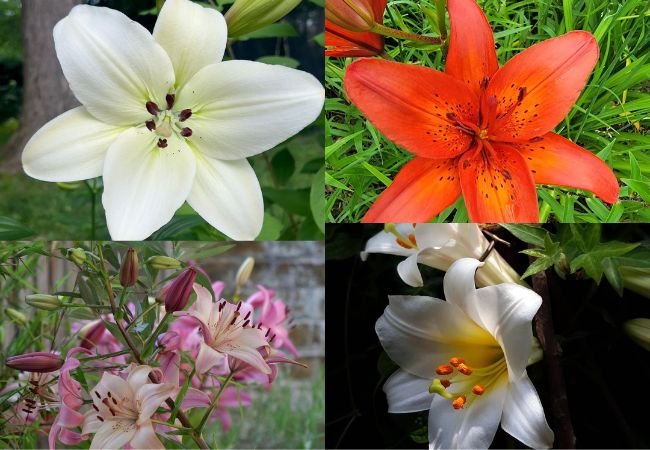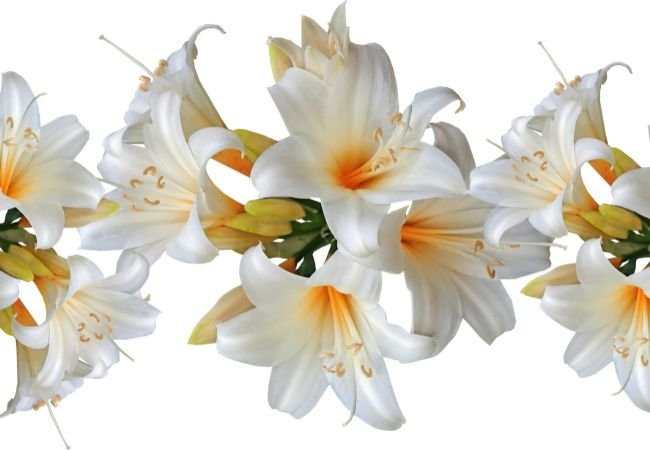Discover the secrets to growing and caring for the stunning Lilies (Lilium) in your garden. This comprehensive guide covers everything from selecting the right varieties and providing optimal growing conditions to proper planting, watering, fertilizing and pest control. Learn expert tips and techniques to ensure your lilies thrive and produce breathtaking blooms year after year.
Lilies (Lilium) are among the most beloved and iconic flowers in gardens worldwide, captivating hearts with their elegant beauty, vibrant colors and enchanting fragrance. These perennial bulbs come in a wide range of varieties, each with its own unique charm and characteristics. Whether you’re a seasoned gardener or a beginner, growing lilies can be an incredibly rewarding experience. In this comprehensive guide, we’ll walk you through the essential steps to successfully cultivate and care for these stunning flowers, ensuring a garden filled with breathtaking blooms.
Here’s an easy chart for Lilies (Lilium spp.):
| Aspect | Information |
|---|---|
| Botanical Name | Lilium spp. |
| Common Name | Lilies |
| Plant Type | Perennial bulb |
| Zones | 3-9 (varies by species and cultivar) |
| Sun Exposure | Full sun to partial shade |
| Soil Type | Well-drained, loamy soil |
| Bloom Time | early summer to late summer and even into the fall |
| Flower Color | Various colors including white, yellow, orange, pink, red and purple |
| Height/Spread | 2-6 feet tall, 1-2 feet wide |
| Special Features | Fragrant, attracts pollinators, deer-resistant |
Selecting the Right Lily Varieties

With over 100 species and countless hybrid varieties, lilies offer an incredible diversity of colors, shapes and sizes. Here are some popular categories to consider:
Asiatic Lilies
Known for their vibrant colors and upward-facing flowers, Asiatic lilies are hardy, early bloomers that thrive in full sun.
Oriental Lilies
These lilies are prized for their large, fragrant blooms and come in a range of colors from white to pink and red.
Trumpet Lilies
As the name suggests, these lilies feature elongated, trumpet-shaped flowers and are often highly fragrant.
Tiger Lilies
With their distinctive orange color and speckled petals, tiger lilies add a bold and exotic touch to any garden.
Planting and Growing Conditions
To ensure your lilies thrive, it’s essential to provide them with the right growing conditions and planting techniques:
Timing
Plant lily bulbs in the fall or early spring, depending on your climate and the variety you choose.
Location
Most lilies prefer full sun to partial shade and well-draining soil. Avoid planting them in areas with standing water or heavy clay soil.
Soil Preparation
Before planting, amend the soil with organic matter like compost or well-rotted manure to improve fertility and drainage.
Planting Depth
As a general rule, plant lily bulbs three times as deep as their height. Space them according to the mature size of the variety.
Watering and Fertilizing
Proper watering and fertilization are crucial for the healthy growth and abundant blooms of your lily plants:
Watering
Lilies require consistent moisture but should never sit in waterlogged soil. Water deeply and allow the soil to dry out slightly between waterings.
Fertilizing
Apply a balanced, slow-release fertilizer formulated for bulbs in early spring when growth emerges. Avoid over-fertilizing, as this can lead to weak stems and fewer blooms.
Staking and Support
Many lily varieties can grow quite tall, making them susceptible to damage from wind and heavy rain. To prevent this, provide support using stakes or grow through plant supports:
Staking
Insert sturdy stakes near the base of the lily plant and gently tie the stems using soft plant ties as they grow taller.
Grow-Through Supports
Place a grow-through support over the lily plant in early spring, allowing the stems to grow up through the openings for natural-looking support.
Pest and Disease Management
While lilies are generally hardy plants, they can be susceptible to certain pests and diseases. Here are some common issues to watch out for:
Lily Beetle
These bright red beetles and their larvae can quickly defoliate lily plants. Regularly inspect your plants and remove any beetles or larvae by hand.
Aphids
These small, sap-sucking insects can cause distorted growth and weaken plants. Control them with insecticidal soap or by introducing beneficial insects like ladybugs.
Botrytis Blight
This fungal disease appears as gray mold on leaves and flowers. Ensure proper air circulation, remove infected parts, and apply a fungicide if necessary.
Deadheading and Propagation
To keep your lilies looking their best and encourage healthy growth, practice regular deadheading and consider propagating new plants:
Deadheading
Remove spent flowers by snipping them off just below the bloom, taking care not to remove the leaves, as they are essential for photosynthesis.
Propagation
Lilies can be propagated by dividing mature clumps or by planting bulbils (small bulbs that form on the stem). Divide clumps in the fall or early spring, ensuring each division has a healthy bulb and foliage.
Winter Care
In colder climates, lilies may require some extra protection during the winter months:
Mulching
After the foliage has died back in the fall, apply a 2-4 inch layer of organic mulch, like straw or leaves, over the bulbs to insulate them from extreme cold.
Lifting and Storing
In areas with severe winters, consider lifting the bulbs in the fall and storing them in a cool, dry place until spring planting.
Companion Planting
Lilies can be beautifully incorporated into mixed borders and companion planted with other perennials and annuals:
Perennial Companions
Pair lilies with perennials like peonies, daylilies, and coneflowers for a stunning and long-lasting display.
Annual Companions
Surround lilies with annuals like cosmos, zinnias, and marigolds to add color and fill in gaps throughout the growing season.
Growing lilies is a truly enchanting and rewarding experience for gardeners of all skill levels. By following the tips and techniques outlined in this comprehensive guide, you’ll be well-equipped to select the perfect varieties, provide optimal growing conditions, and nurture your lilies through proper planting, watering, fertilizing, and pest management. With patience and care, your garden will soon be graced with the breathtaking beauty and heavenly fragrance of these stunning flowers. Embrace the joy of cultivating lilies and watch as they transform your outdoor space into a true garden paradise.








Leave a Reply